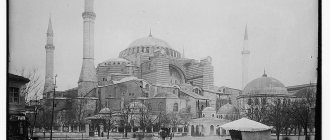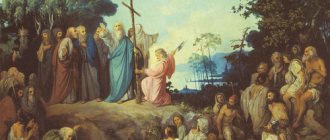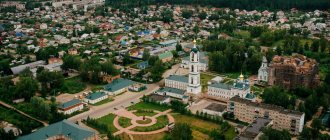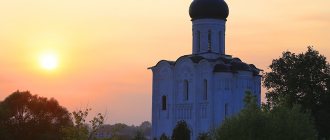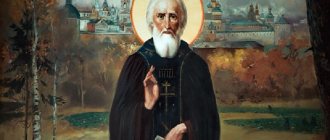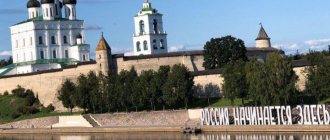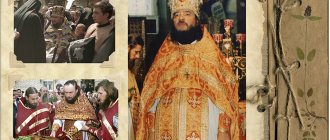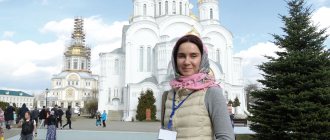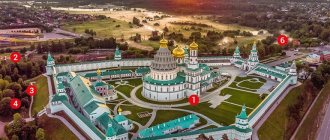Venerable Simeon the Stylite of the 15th century, Novgorod school Wood, tempera, 72 cm * 47 cm Novgorod State United Museum-Reserve
Asceticism, as a form of asceticism, began to take shape in ancient times. It became an experimental expression of the ascetic tradition, in contrast to the theoretical dogmatic-theological one, and was based on self-discipline and self-restraint. The goal of ascetic practice was the acquisition of the Holy Spirit, deification, which act affected both the soul of a Christian and the body. The carnal shell was involved in the process of spiritual transformation, but not every ascetic mortified his flesh in the same way as, for example, the Monk Simeon the Stylite, the actual founder of Styliteism, a completely new form of asceticism in those days.
Life of a Saint
Saint Simeon came from the family of pious Christians Susotion and Martha. He was born in the 4th century in Cappadocia. In his youth, he tended his father's sheep.
One day, having come to the temple, the young man heard the Beatitudes being sung. The words from Christ’s Sermon on the Mount struck him so much that Simeon decided to follow the gospel teaching in everything.
He prayed to the Lord for a long time, and then, having collected his simple belongings, he left his father’s house. He walked to the monastery, located near his native village, and, having reached the monastery, fell in front of the gate and did not rise for seven days until he was accepted into the ranks of the brethren.
Feats
On the day of his majority, he took on the “angelic image,” that is, he was tonsured a monk. Simeon was so zealous in his spiritual exploits that he aroused the discontent of the brethren, and the abbot asked the saint to leave the monastery. Simeon fulfilled the order of the abbot and went to the mountains. There he came across a dry well, in which reptiles lived, and settled at the bottom, constantly praying and subjecting his flesh to severe tests.
At this time, the abbot of the monastery had a dream in which many people with burning candles and weapons in their hands approached the monastery and shouted that they would burn the monastery if Simeon was not shown to them.
Frightened to death, the abbot equipped a search party of monks and sent it to search for the holy ascetic. Having forcibly pulled Simeon out of the well (for the ascetic did not want to leave his refuge), the monks brought the monk back. Simeon did not stay long in the monastery - his soul longed for solitude. He left the monastery as secretly as his father’s house had once done, and went on a journey. He did not wander for long - he found a cave in the rocks near the village of Talanissa and shut himself up in it for three years.
Hermit
Once during Great Lent, Saint Simeon wanted, like Christ, to spend all forty days without eating food or even drinking. With God's help, he managed to do this, and since then he has repeated this feat several times. Having heard about the holy ascetic, many people began to flock to the place of his voluntary imprisonment. They violated Simeon’s prayerful solitude, and the saint figured out how to get away from them without moving away.
A feat pleasing to God
He built a four-meter pillar, and on its top he built a kind of cell. There he lived, improving in his spiritual exploits.
The Desert Fathers, having heard about a hitherto unknown form of asceticism, decided to test Simeon. They sent people to him with orders to force Simeon to come down from the pillar, even if by force. If a saint shows humility and submits, then his feat is pleasing to God. Having listened to the will of the desert fathers, Simeon put his foot on the stairs to get down, but the messengers shouted: “No, don’t go down, holy father, but stay on the pillar: now we know that the work you started is from God. May He be your helper to the end.”
Interesting fact
Saint Simeon constantly increased the height of his pillar and by the end of his life he stood on a column 40 cubits high (about 17 meters). The pillar was surrounded by a double fence so that no one could approach the hermit without his permission.
Women were not allowed outside the fence at all. Simeon did not even make an exception for his mother. This poor woman had been looking for her son for many years, and when she finally found him, he did not even allow her to approach his pillar. She died like that, hugging the fence with her hands.
In the life of the saint it is said that his body was constantly eaten by worms, but he did not treat his ulcers. On the contrary, he collected the larvae that had fallen from the wounds, pushed them back and said: “Eat what God sent you.”
“I,” said Blessed Theodoret, “first of all am amazed at his patience: night and day he stands so that everyone can see him. It happened once that the doors and a considerable part of the upper wall fell apart from disrepair, and until the wall and doors were made again, the saint was visible to everyone for a considerable time. Then they saw a new and amazing sight: sometimes he stood motionless for a long time, sometimes he offered prayers to God, making frequent bows. One of those standing at the pillar said that he wanted to count the bows that the ascetic made without ceasing, and, having counted one thousand two hundred and forty-four, he became exhausted and, unable to look at the height of the pillar, stopped counting. The saint, however, did not become exhausted from bowing, but by eating food once a week, and then very small and light, he became light and capable of frequent bowing. As a result of standing for a long time, an ulcer opened on his other leg that was not healing, and a lot of blood flowed out of it. But even this suffering could not distract him from his thoughts of God.”
Miracles of the Reverend
In the life of St. Simeon Stolpinok there are references to various miracles performed through his prayers. He healed both people and animals, and the latter themselves came to him. One day a large snake crawled up to the pillar. He seemed to be suffering from something, writhing his whole body. It turned out that a branch had stuck into the snake’s eye, but as soon as the saint looked at the reptile, the branch immediately fell out of the snake’s eye.
Useful materials
The land on which Saint Simeon labored suffered from lack of water. The ascetic prayed to God, and the ground near his fence opened up and water poured out.
A relative of a Saracen commander fell ill. They brought him to the pillar of the saint, in the hope that Simeon would help the young man. The monk asked the patient whether he believed in the Holy Trinity, and when the young man answered in the affirmative, he ordered: “Rise up.” The young man immediately became healthy, as if he had not been sick at all. He placed his relative-military leader, a rather corpulent man, on his shoulders in order to demonstrate to everyone that his strength had returned to him, and so he went home.
The queen of the Israelites, who had tried in vain to conceive for several years in a row, sent ambassadors to the elder, asking for his holy prayers. Pretty soon she gave birth to a healthy boy, whom she handed over to the monk in the arms of slaves so that he could look at the “fruit of his prayers” and bless the baby.
Stylites and hermits
Instead of a preface
The name pillars in the Christian Church is given to the few hermits who labored on the pillars. These pillars were made of wild stones, sometimes by the pillars themselves, and were of varying heights. On their tops, which had no more than two cubits in diameter, railings or huts, mostly open, were placed, which warned the ascetics from falling and served as a support for them during their extreme exhaustion. Spending days and nights in repentance, contemplation and praise, the pillars with amazing courage endured all the hardships of nature. Wet by the rain, burned by the heat, tormented by the cold, sometimes under heavy chains, they, as if nailed, stood motionless on the pillars. These were “self-willed martyrs” who carried the cross of Christ, but, better yet, hung on it for many years, dying every day.
Unfairly, or at least without reason, some say that this type of asceticism was known back in the 2nd century. In the history of the first four centuries, the name stylite does not appear. Theodoret, the first of the writers, tells the story of Simeon, a Syrian hermit who lived in the 5th century. Simeon's new and extraordinary exploits aroused the greatest surprise in everyone and produced imitators. The first imitator of Simeon's life was his disciple Daniel the Stylite. Evagrius, as a contemporary and eyewitness, mentions two other pillars, Simeon the Younger (Divnogorets) and his mentor. Stylites appeared, although rarely, even after, until the 12th century, such as Alypius of Adrianople, who lived under Heraclius, Luke the New - during the reign of Constantine Bagrynarodny, and Nikita of Pereslavl, who shone with his exploits on the pillar in the 12th century. But, in general, the life of stylites is a rare phenomenon in the Christian Church.
The Stylites, blessed and revered by our Orthodox Church, in modern times in the West have become the subject of ridicule. Some Catholics, Protestants and everyone who has had the opportunity to write about the stylites pour out bile at them from their pens, call their way of life unworthy of a Christian person and explain it either with pride or fanaticism.
So, the stylite life, due to its unusualness and rarity, and due to the reproaches and attacks to which it is subjected in modern times in the West, involuntarily attracts the attention of those who take part in the affairs of the Church of Christ and for whom everything is dear, and even more so the extraordinary a phenomenon occurring in it.
What forced the hermits to retreat from their ordinary ascetic life and undertake a new, extremely difficult way of life - standing on pillars?
Some explain this with pride: they say that the desire to distinguish themselves by their strangeness, to gain fame as extraordinary ascetics and to attract crowds of admirers forced some desert dwellers to climb the pillars.
To test yourself with exhaustion, to suffer for 80 years only because of one proud desire to attract people’s gaze and make them talk about oneself as a great ascetic is completely unrealistic and incredible.
No, the voice of some strange and incomprehensible pride that they want to see in the stylites cannot stand against the voice of nature and the sense of self-preservation. A person who acts out of pride sometimes sacrifices a lot to achieve his goals; but his donations are short-lived and can never extend to such amazing selflessness to which the stylites subjected themselves.
Moreover, the innermost spirit or character of a person is necessarily revealed in his activities. But what do we see in the life of the pillars? An example of humility: all their words and actions are marked by deep humiliation. Simeon, respecting everyone without exception, called himself nothing more than a despised and rejected monk. He always tried to cover up the wisdom of his advice with some special simplicity and modesty, and he himself listened to the advice of others; He attributed the countless and varied healings he performed solely to the grace of God and with a terrible threat forbade those healed to speak about his name; Constantly aware of his guilt and unworthiness before God, he usually entrusted himself to the prayers of others who had shone with deeds and virtues. He accepted his unjust excommunication from society without a murmur and, without any contradiction, obeyed the demand of the Syrian envoys, who ordered him to descend from the pillar. We see the same meekness, the same humility in the life of Daniel the Stylite. No slander or insult could arouse anger and revenge in him. He forgave all insults inflicted on him, prayed for his enemies and healed slanderers.
Others of the newest explain the stylite life as fanaticism. But this is also incorrect. The Stylites cannot be blamed for a lack of wisdom and correct knowledge of subjects, especially religious ones, otherwise one must unfairly assume an extreme degree of ignorance in all their contemporaries, because the Stylites were revered as the sages of their time. Their wisdom is attested and glorified by all their contemporaries. Thousands of people came to listen to the teachings of the pillars; they were visited by kings and nobles, patriarchs and scientists (such as Theodoret of Cyrus, for his extensive information and wisdom called the miracle of his age, Evagrius, Theodore the reader, Cosmas the Chaldean priest, and others), and everyone was amazed at the wisdom that came from their lips . Especially the first stylite was famous for his gift of insight and advice. According to the needs and demands of the people, he devoted several hours every day to listening to and resolving various issues, perplexities and strife proposed to him, and all his words and advice were accepted and carried out as inspired by God. The emperors - Theodosius, Leon and Marcian - more than once used his instructions in difficult cases. Thus, Theodosius, on the occasion of the discord that arose between Cyril and John of Antioch at the Council of Ephesus, wrote to Simeon, as to such a man who alone, through the wisdom of his advice and the power of prayers, could put an end to disagreements and restore peace in the Church. Daniel was the highlight of the reign of Leo, who respected the stylite so much that he repeatedly came to him in simple clothes to receive his blessing and advice. Simeon Divnogorets, even in infancy, surprised with his answers and questions the experienced Elder John, abbot of the Pilsky Monastery, known in his time for spiritual wisdom. In general, the narrators of the lives of the stylites present them as sages, in whom all words and actions are based not on an unconscious feeling, but on the right consideration of the mind, on a deep knowledge of the Christian faith and human nature.
We see no severity or harshness either in the character or in the actions of the pillars, so they cannot be considered fanatics. Being strict only towards themselves, they were compassionate, condescending and affectionate towards everyone, and were even distinguished by their special love and friendliness; they entered into the condition and needs of the unfortunate, took part in public disasters, trying to alleviate them with their advice, prayers, intercession and consolation; in a word, these were the great benefactors of humanity, joyful luminaries who spread warmth, life and joy around them, and therefore involuntarily attracted the hearts of people. Many of those who came to them did not want to leave them and, leaving their homes and estates, settled near the pillars in order to constantly enjoy seeing the pillars and learn from their conversations. Therefore, near each stylite, little by little monasteries arose and large monasteries were established.
The consequences of the stylite life, as we will see later, were salutary both for the stylites themselves and for the people. Remaining faithful to their rules until the end of their lives and faithfully achieving their high goals, the stylites were an example of virtue for everyone and the reason for the salvation of many, and therefore deserved universal blessing from their contemporaries, glorified and are still glorified by the entire Orthodox Church.
No, not pride or fanaticism, as some think, but something else was the victorious reason and the beginning of the stylite life. And, without a doubt, the reasons for this extraordinary phenomenon must first of all be sought in the spirit and direction of monasticism of the 5th century, in which the stylites appeared and became especially famous. Monasticism in the 5th century reached full development and was distinguished by a special, extraordinary severity of life. Theodoret, starting to describe the life of the hermits of the 5th century, demands faith from his readers, because he, indeed, speaks of such feats, which, apparently, exceed human strength and probability. Some of the hermits, according to him, doomed themselves to constant wandering through uninhabited places and, despite the heat and cold, covered only those parts of the body that nature suggests to cover; others were enclosed in huts or caves so cramped and low that it was impossible to stay in them without bending over; others condemned themselves to internal and external silence; many wore heavy iron chains or chains; Everyone generally kept a continuous fast, which lasted from 7 to 40 days without eating food. The zeal for the mortification of the flesh was extraordinary. The elders and abbots set an example of self-sacrifice for their students, the students tried to surpass their teachers. With such an ascetic spirit, with such religious heroism of the hermits, it was possible and even necessary to expect great, extraordinary ascetics. And among the deserts, like the flower of asceticism, appear the stylites who reach the final degree of selflessness and patience[1].
Death and relics
2
September
459
Saint Simeon died at the seventieth year of his life. He died in prayer, kneeling. The ascetic spent thirty-seven years on the pillar.
When his disciple Anthony climbed onto his pillar, he did not immediately realize that the monk was dead. In the life of the saint it is said that they mourned the death of the great ascetic so much that “the nation’s cry was heard in seven stages.”
Interesting fact
The relics of the saint were transferred to Antioch, and a few years later a beautiful stone church was built, consecrated in the name of the saint. In 467, the holy relics were transferred by Emperor Leo Macella to Constantinople and placed near the pillar of St. Daniel the Stylite in the Anaplus region, where the tomb of St. Simeon was subsequently erected.
Particles of the relics of Saint Simeon were transferred to the West. A fragment of the head is kept in the Italian city of Arezzo, and the saint’s finger ended up in Venice, in the Church of St. George (San Giorgio dei Greci). More particles are found in monasteries on Mount Athos, and part of the right hand of the saint is kept in a silver reliquary in the Monastery of the Transfiguration of the Lord in Mutsiali in the region of Veria.
Notes
| Stylites at Wikimedia Commons |
- ↑ 123
V. M. Zhivov Holiness. A brief dictionary of hagiographic terms. Moscow, "Gnosis", 1994 - Stylites // Encyclopedic Dictionary of Brockhaus and Efron: in 86 volumes (82 volumes and 4 additional). - St. Petersburg, 1890-1907.
- Frese A. A. [actual-art.spbu.ru/testarchive/10007.html Monastic architecture and the tradition of pillars in Byzantium and Ancient Rus' in the 9th - early 13th centuries] // Actual problems of theory and history of art: collection. scientific articles. Vol. 4. / Ed. A. V. Zakharova, S. V. Maltseva. - St. Petersburg: NP-Print, 2014. pp. 90-98. — ISSN 2312—2129
- Pavich M.
[lib.ru/INPROZ/PAWICH/hazarman.txt Khazar dictionary].
| Faces of holiness in Orthodoxy |
| Apostle | Unmercenary | Blessed | Blessed | Godfather | Great Martyr | Confessor | Martyr | Righteous | Forefather | Venerable Martyr | Reverend | Reverend Confessor | Prophet | Equal to the Apostles | Saint | Priest Confessor | Hieromartyr | Stylite | Passion-bearer | Miracle Worker | Holy Fool |
Monastery
This monastic monastery, built in the fifth century, is now a picturesque ruin. They are located sixty kilometers from the ancient city of Aleppo (now Aleppo), in Syria.
Interesting fact
The history of the origin of this monastery is closely intertwined with the life of St. Simenon - it was on the spot where the ascetic’s pillar was located that a beautiful cruciform church was later built. The remains of a pillar with a large block of stone have been preserved to this day - silent evidence of the spiritual exploits of the holy hermit.
This temple stood on the very edge of a cliff, and monastic cells were erected around it. The builder of the monastery was the Byzantine emperor Zeno. Over the centuries of its existence, the monastery was plundered more than once. Its owners were either the Seljuk Turks or the Crusaders.
In the 12th century, the monastery was again taken over by the Arabs, and the monastery gradually fell into disrepair. Today, the egg-shaped remains of the pillar of St. Simeon are a place of Christian and tourist pilgrimage. People break off pieces of stone to take them with them, because it is believed that these stones can heal various diseases.
Iconography
The first images of Simeon the Stylite date back to the turn of the 5th-6th centuries, that is, they began to appear immediately after the death of the saint. They are very sketchy in nature and carved on stone. Many of these bas-reliefs are kept in museums in different countries: Syria, Berlin, France.
The subjects of the icons are varied, but they have one thing in common: Saint Simeon is almost always depicted standing on a pillar.
Many of the icons are hagiographic, that is, they reproduce certain episodes from the life of the saint.
Venerable Simeon the Stylite with the Life of Tver, ca. 1713 Wood, tempera. 118 × 97 cm Museum of Ancient Russian Culture and Art named after. Andrey Rublev
Rarely does a woman appear on the icons of Simeon the Stylite - his mother, hugging a column. In fact, the reverend did not even allow her to approach his pillar.
There are icons with stamps - additional images located in a row on the sides of the central picture. They briefly tell us about the entire life of the holy hermit. One of these icons, dating from the 16th century, is kept in the Tretyakov Gallery in Moscow. Often Saint Simeon can be seen in the company of other saints: Onuphrius the Great and Stylian of Paphlagonia, Saints Susanna and Marciana, as well as other stylites.
Interesting fact
A very rare subject is the descent of Saint Simeon from the pillar. The monk is depicted with his leg hanging from a stone railing. Obviously, this plot originates from the life story of the pillar, when the desert fathers, testing the faith of the saint, ordered him to leave the pillar.
One of the most striking monuments of icon painting is the image of Simeon the Stylite on a fresco in the Church of the Transfiguration of the Lord on Ilyin Street in Novgorod. Author: Theophanes the Greek. The saint was painted in ocher and white in the company of his two other followers - Simeon the Divnogorets and Alypius the Stylite.
Stylites Simeon the Elder, Simeon the Younger Divnogorets, Alypiy Theophanes the Greek, 1378 Church of the Transfiguration on Ilyin Street, Novgorod, Russia Fresco in the choir chamber
With his feat, Saint Simeon inspired many ascetics of faith and piety. He became the founder of a new form of Christian asceticism - pillarism. His first follower was Daniel, who labored on a pillar in the Thracian desert. Of the Russian stylites, the most famous are Nikita, Savva Vishersky and Seraphim of Sarov, who stood on the stone for a thousand days.
Author: Galina Bocharova
The feat of pillarism in the Russian Orthodox Church
Photo: Pravlife.org
Bishop Kirill of Turov, who lived in the 12th century, is considered the first stylite in the Russian church. His life notes that soon after taking monastic vows at the Boris and Gleb Monastery, he climbed the pillar, where he spent a large amount of time in prayer.
While on the pillar, he composed many works, gaining well-deserved fame. Later, Kirill became the bishop of Turov.
Another famous stylite who lived in Rus' is St. Nikita of Pereslavl. True, his pillar was inside the earth, since it was a round cave. His pillarism is also a unique form of seclusion.
The Monk Savva of Vishera began to stand on the pillar in the 15th century, going to a secluded place on the banks of the Vishera near Novgorod. In 1418, he founded a monastery on this site dedicated to the Ascension of the Lord. Next to the monastery, Savva erected a pillar on which he spent every week from Monday to Saturday in prayer and fasting. On Saturday, Savva came down to give communion to the brothers, and the next day he conducted Sunday service.
Among the Orthodox stylites, it is necessary to mention the Venerable Seraphim of Sarov. Every night he climbed a large stone in the forest, on which he prayed, raising his hands to the sky. He spent the day in his cell, and so he spent 1000 days.
Prayer
Oh, holy and great saint of God Simeon! Having fought a good fight on earth, you received in heaven the crown of righteousness, which the Lord has prepared for all who love Him. Moreover, looking at your holy image, we rejoice at the glorious end of your life and honor your holy memory. But you, standing before the Throne of God, accept our prayers and bring them to the All-Merciful God, to forgive us every sin and help us to stand against the wiles of the devil, so that we may be freed from sorrows , illnesses, troubles and misfortunes and all kinds of evil, let us live piously and righteously in the present and through your intercession we will be worthy, even though we are unworthy, to see good on the earth of the living, glorifying the One in His saints, glorifying God, the Father and the Son and the Holy Spirit, we forever and ever. Amen.
Second prayer
Oh, sacred head, holy father, most blessed Abvo Simeon! Do not forget your poor to the end, but always remember us in holy and favorable prayers to God: remember your flock, even if you yourself fell, and do not forget to visit your children, pray for us, Father sacred, for your spiritual children, for you have boldness to To the Heavenly King: do not keep silent to the Lord for us, and do not despise us who honor you with faith and love: remember us unworthy at the Throne of the Almighty, and do not cease praying for us to Christ God, for goodness has been given to you let him pray for us. We do not think that you are dead: even though you have passed away from us in body, you remain alive even after death, do not depart from us in spirit, keeping us from the arrows of the enemy and all the delights of demons and the wiles of the devil, Our good fellow. Even though the relics of your cancer are always visible before our eyes, but your holy soul with the Angelic hosts, with the Bodiless faces, with the Heavenly powers, stands at the Throne of the Almighty, worthy of rejoicing Knowing that you are truly alive even after death, we bow down to you and We pray to you: pray for us to the Almighty God, for the benefit of our souls, and ask us time for repentance, so that we may pass from earth to Heaven without restraint, from bitter ordeals, demons of the princes of the air and from eternal misery May we be delivered, and may we be heirs of the Heavenly Kingdom with all the righteous, who from all eternity have pleased our Lord Jesus Christ: to Him belongs all glory, honor and worship, with His Father who is without beginning, and with His Most Holy and Good and Life-giving Spirit, now and forever, and to the ages of ages. Amen.
Excerpt characterizing the Stylite
- Sonya, you can’t doubt him, you can’t, you can’t, do you understand? – she shouted. – Does he love you? - Does he love you? – Natasha repeated with a smile of regret about her friend’s lack of understanding. – You read the letter, did you see it? - But what if he is an ignoble person? – Is he!... an ignoble person? If only you knew! - Natasha said. “If he is a noble man, then he must either declare his intention or stop seeing you; and if you don’t want to do this, then I will do it, I will write to him, I will tell dad,” Sonya said decisively. - Yes, I can’t live without him! - Natasha screamed. - Natasha, I don’t understand you. And what are you saying! Remember your father, Nicolas. “I don’t need anyone, I don’t love anyone but him.” How dare you say that he is ignoble? Don't you know that I love him? – Natasha shouted. “Sonya, go away, I don’t want to quarrel with you, go away, for God’s sake go away: you see how I’m suffering,” Natasha shouted angrily in a restrained, irritated and desperate voice. Sonya burst into tears and ran out of the room. Natasha went to the table and, without thinking for a minute, wrote that answer to Princess Marya, which she could not write the whole morning. In this letter, she briefly wrote to Princess Marya that all their misunderstandings were over, that, taking advantage of the generosity of Prince Andrei, who, when leaving, gave her freedom, she asks her to forget everything and forgive her if she is guilty before her, but that she cannot be his wife . It all seemed so easy, simple and clear to her at that moment. On Friday the Rostovs were supposed to go to the village, and on Wednesday the count went with the buyer to his village near Moscow. On the day of the count's departure, Sonya and Natasha were invited to a big dinner with the Karagins, and Marya Dmitrievna took them. At this dinner, Natasha again met with Anatole, and Sonya noticed that Natasha was saying something to him, wanting not to be heard, and throughout the dinner she was even more excited than before. When they returned home, Natasha was the first to begin with Sonya the explanation that her friend was waiting for. “You, Sonya, said all sorts of stupid things about him,” Natasha began in a meek voice, the voice that children use when they want to be praised. - We explained it to him today. - Well, what, what? Well, what did he say? Natasha, how glad I am that you are not angry with me. Tell me everything, the whole truth. What did he say? Natasha thought about it. - Oh Sonya, if only you knew him like I do! He said... He asked me about how I promised Bolkonsky. He was glad that it was up to me to refuse him. Sonya sighed sadly. “But you didn’t refuse Bolkonsky,” she said. - Or maybe I refused! Maybe it's all over with Bolkonsky. Why do you think so badly of me? - I don’t think anything, I just don’t understand it... - Wait, Sonya, you will understand everything. You will see what kind of person he is. Don't think bad things about me or him. – I don’t think anything bad about anyone: I love everyone and feel sorry for everyone. But what should I do? Sonya did not give in to the gentle tone with which Natasha addressed her. The softer and more searching the expression on Natasha’s face was, the more serious and stern Sonya’s face was. “Natasha,” she said, “you asked me not to talk to you, I didn’t, now you started it yourself.” Natasha, I don't believe him. Why this secret? - Again, again! – Natasha interrupted. – Natasha, I’m afraid for you. - What to be afraid of? “I’m afraid that you will destroy yourself,” Sonya said decisively, herself frightened by what she said. Natasha's face again expressed anger. “And I will destroy, I will destroy, I will destroy myself as quickly as possible.” None of your business. It will feel bad not for you, but for me. Leave me, leave me. I hate you. - Natasha! – Sonya cried out in fear. - I hate it, I hate it! And you are my enemy forever! Natasha ran out of the room. Natasha no longer spoke to Sonya and avoided her. With the same expression of excited surprise and criminality, she walked around the rooms, taking up first this or that activity and immediately abandoning them.
Akathist
Kontakion 1
To the chosen lamp of the world from infancy and healer of mental and physical ailments to our venerable father Simeon, humbly flowing, as if he can free us from passions and all troubles, from the depths of the soul let us offer praise and prayer, earnestly calling: Rejoice, Simeon, wondrous and great pillar more miraculous.
Ikos 1
A Guardian Angel was given to you by God, when the fruit of fervent prayer was bestowed upon you by your parent.
Preserving you, and even more so teaching you in spiritual wisdom, when you were dressed in snow-colored clothes at your baptism. We, knowing that you are a wonderful chosen one of God, dare to bring this praise to you, as it should be: Rejoice, the fruit of your parents’ prayer was God-given. Rejoice, you have been granted the gifts of the Holy Spirit in holy baptism. Rejoice, chosen vessel of God's grace. Rejoice, the love of God manifested by man. Rejoice, unlearned of earthly wisdom. Rejoice, highly enriched with heaven. Rejoice, mysteriously deified by the Body and Blood of Christ. Rejoice, caught up in prayer. Rejoice, Simeon, wondrous pillar-bearer and great miracle worker. Kontakion 2
Seeing the Lord the humility and simplicity of your heart, He chose you as His weapon, so that you may confound the evil wisdom of the wise men of this age, and from the sheep of your father make you shepherds of the verbal sheep of the flock of Christ, so that you may sing to the Creator: Alleluia.
Ikos 2
Having your mind hungry and thirsty for the righteousness of Christ, you did not hesitate to ask the honest elder about the words of the Holy Gospel.
And, having learned from his God-taught words, at that same hour you firmly desired to leave your father’s house and all the red things of this world and to drink along the narrow path leading to the eternal belly. For this reason we cry out to you: Rejoice, you who have loved staying in the temple from your youth. Rejoice, you who left your father’s house. Rejoice, covering those who run around the world. Rejoice, God-pleasing image. Rejoice, having accepted the good yoke of Christ with love. Rejoice, thou who cut the flesh as with a sword. Rejoice, guide those who are lost. Rejoice, affirm the goodness of those who live. Rejoice, Simeon, wondrous pillar-bearer and great miracle worker. Kontakion 3
By the revelation of God, you saw a vision in a dream: laying the foundation of a building, you dug a ditch and heard a voice three times, and went deeper, and having reached many depths, the Lord commanded you to build with all your zeal.
And this wonderful vision came true over you: with the depth of humility you laid a solid foundation for all virtues, with which you were adorned, you constantly cried out to the Lord: Alleluia. Ikos 3
Having a strong desire for a monastic life, you came to the one monastery.
For the sake of humility, you fell to the ground for seven days without food or drink before its gates, not having the courage to enter into it. The blessed abbot of that monastery, foreseeing you to be God's chosen one, tested you in the past days, as if you wanted to work for the Lord, and count your brethren in the face. And we all honor you: Rejoice, true listener of the commands of Christ. Rejoice, jealous of the life of the equal angels. Rejoice, you who have left this world. Rejoice, thou who passionately desired the life of fasting. Rejoice, armed with abstinence against passion. Rejoice, good soldier of Christ. Rejoice, you who in humility subdued yourself to obedience. Rejoice, diligence leading to monastic teaching has been revealed. Rejoice, Simeon, wondrous pillar-bearer and great miracle worker. Kontakion 4
Calming the storm of passions, like a meek lamb, you always listened to your spiritual fathers and, for your humility, while still young, you were honored with the image of an angel, in which you aggravated abstinence and labors, you mortified the flesh, saving your soul, and in the depths of your heart crying out to God: Alleluia.
Ikos 4
Hearing the abbot tell the brethren that a stench emanates from you and worms are falling from your body, ask you why this happened.
You, bowing your head, stood in silence. Then I took your clothes and saw your blood-stained body, with a hard rope stuck into it. With much horror we think of your suffering and we call to you: Rejoice, sanctified dwelling of the Holy Spirit. Rejoice, the image of God is not darkened in itself. Rejoice, you who astonished the brethren with Job’s patience. Rejoice, you who have shown great courage within yourself. Rejoice, zealot of truth. Rejoice, lamp of fragrant oil. Rejoice, thou who renew the corrupt temples of our souls. Rejoice, you have cast down the idols of our wisdom. Rejoice, Simeon, wondrous pillar-bearer and great miracle worker. Kontakion 5
We strengthen you with the power of grace; you have undertaken new labors to mortify your flesh.
Out of fear, because the brethren, imitating you, will not accept the feats according to reason, command the abbot to take care of them. But you, without malice, fulfilling his will, you settled in the desert in a waterless well, and there you sang the song to Christ God: Alleluia. Ikos 5
Seeing the blessed abbot Timothy in a dream, seeing a multitude of people in his abode and asking about the servant of God Simeon, he was overcome with horror and, having risen from sleep, the brethren told this.
Abiye went with them into the desert and called out to you. We honor your deeds, and we dutifully magnify you: Rejoice, you who showed the strength of Joseph’s spirit. Rejoice, having accomplished the great deeds of Christ for the sake of Christ. Rejoice, you who bore the Cross of Christ without complaint. Rejoice, decoration of the Church. Rejoice, marvelous servant of God's truth. Rejoice, good pilot of the ship of Jesus. Rejoice, rule of pious faith. Rejoice, image of spiritual meekness. Rejoice, Simeon, wondrous pillar-bearer and great miracle worker. Kontakion 6
The preacher of the word of God, Bishop Vass, came by the will of God, when you settled in a desert cell.
Having shown great zeal for Moses and Elijah, you desired a fourty-day fast. May you not partake of the food during this time, but build your holy saint’s cell without entry, praying, and do it, and go away, singing to the Lord: Alleluia. Ikos 6
You shone, O reverend, with your wonderful abstinence, when the day of your fast passed, the saint of God found you lying dead on the ground, vouchsafed you and the Mysteries of Christ’s immortal communion.
Therefore, having told many brethren about your wondrous struggle, teach them to glorify the Lord, revealing your wondrous deeds in His saints, and to you, His saint, to sing in praise: Rejoice, you who have walked your earthly path in the footsteps of Christ. Rejoice, you who imitated Moses and Elijah by fasting. Rejoice, having placed your trust in the Lord. Rejoice, you who did not partake of this hope of food and drink. Rejoice, for you have been illuminated with divine light. Rejoice, for you strengthen us, the faithful, with your prayers. Rejoice, for through incorporeal abstinence you have become like yourself. Rejoice, for you have conquered invisible enemies with spiritual weapons. Rejoice, Simeon, wondrous pillar-bearer and great miracle worker. Kontakion 7
Although you would rather aggravate your exploits, as if you had ascended to the top of a mountain on a ladder leading to heaven: lest you descend from there, establish yourself on it with shackles, having listened to the words of Saint Meletius, captivating not the flesh, but the mind into Christ’s obedience, to the end You cried out from your belly: Alleluia.
Ikos 7
New Bethesda, a mountain appeared, on which you labored, the most holy one.
Not only in the summer and first of all was healing given to those who entered, but also always and to everyone in troubles, illnesses and sorrows, and with hope flowing to God, your good help was granted, and everyone returned, glorifying God, and you, the saint of His greatness, calling: Rejoice, O Light, kindled by the Divine flame. Rejoice, lamp that burns and shines. Rejoice, healer of mental illnesses. Rejoice, physician of bodily ailments. Rejoice, feeder of those who hunger for righteousness. Rejoice, you who thirst for truth. Rejoice, prayer book for our souls. Rejoice, I am an intercessor for us and earthly blessings. Rejoice, Simeon, wondrous pillar-bearer and great miracle worker. Kontakion 8
You have created a strange life, O blessed one, when you see many people coming to you, knowing that they honor and glorify you.
Fleeing from glory, having loved humility, you were pleased to remain on the pillar on high and, as if ascending by the degree of a ladder to the heavenly heights, and the frost, and the rain, and the scorching heat, enduring the scorching heat, you continually sang to the Lord: Alleluia. Ikos 8
You were completely filled with obedience to those testing you by the holy desert father: obeying their command, as if it were God, you tried to bring down from your pillar to the ground, even seeing the hedgehog, understanding that your work was from God, and deciding that you would remain on the pillar yours is not forbidden.
Then the enemy of the human race intended to tempt you: to appear in the form of an angel of light, but for a moment you did not understand, blessed one, the flattery of the enemy, but by the sign of the honorable Cross you defeated that deceit. Afterwards, you brought great repentance to the Lord, and having learned this, we praise you: Rejoice, you who repelled the flaming arrows of the evil one. Rejoice, conqueror of the enemy’s deceit. Rejoice, armed with the power of the cross. Rejoice, you who have consumed lies with the fire of truth. Rejoice, armed with prayer like a sword. Rejoice, thou crowned with the helmet of salvation. Rejoice, you who brought deep repentance to God. Rejoice, having placed your hope in God's mercy. Rejoice, Simeon, wondrous pillar-bearer and great miracle worker. Kontakion 9
The Lord accepts every sinner who repents, and your repentance is accepted, and again glorify you.
The devil, not tolerating your deed, strikes you with a fierce ulcer, and there will be a fierce pus with worms in your nose. After many times your mother had heard about you and came to your pillar and wept bitterly. But you, blessed one, trusting in the will of the Lord, in the future you promised to give her a rest and, having given up her spirit in the hand of the Lord, having made a prayer, you sang to the Lord: Alleluia. Ikos 9
The superstitious Vetians will not be able to explain the power of your miracles, which you performed for the glory of God and in the wonderful name of the Lord.
There was no water for that place, through your prayer, holy one, the earth shook and water was given abundantly. A certain woman, who received a small serpent in water into her womb, drank from your water and healed Abi. And others healed many others at your pillar with your holy prayers. People, seeing the great miracles of God, glorify you with joy: Rejoice, good and faithful servant of the Heavenly King. Rejoice, aggravating talent received from Him. Rejoice, you who make the heavens rejoice through your life. Rejoice, amazing wonder of the universe. Rejoice, our helper and prayer book. Rejoice, protector from the temptations of the enemy. Rejoice, for through you our passions are quenched. Rejoice, for through you our good desires are fulfilled. Rejoice, Simeon, wondrous pillar-bearer and great miracle worker. Kontakion 10
Although you saved sinners and called them to repentance, you followed the footsteps of our Lord Jesus Christ and you did not betray the thief Jonathan, who came under your roof to those who wanted to kill him, but after his great repentance, you begged him to go in peace to the Lord, so that you could gain the bliss of paradise , in eternity will praise the All-Generous Man-lover God with a song of gratitude: Alleluia.
Ikos 10
Thou art a good servant and faithful servant of the Heavenly King and Lord, and a merciful father and mentor of thy spiritual child: in one place, on a pillar unto thee, a multitude of people, both faithful and unfaithful, come to thee, and every helper to all You were the one who healed all kinds of mental and physical illnesses, and especially you enlightened the unbelievers with the light of Christ’s Gospel, so that by baptism in the name of the Most Holy Trinity, they would extol the Lord and cry out to you, their good shepherd: Rejoice, mirror of the Trisian Light.
Rejoice, filled with heavenly illumination. Rejoice, enlighten your neighbor from the riches of the spirit. Rejoice, teach the fear of God. Rejoice, obedient executor of the will of the Lord. Rejoice, for the glory of His zealot. Rejoice, our good shepherd. Rejoice, merciful and meek father. Rejoice, Simeon, wondrous pillar-bearer and great miracle worker. Kontakion 11
Bringing singing to the beloved Christ in your life, you were honored with the gift of prophecy, foreshadowing the coming drought, famine and pestilence, you predicted the invasion of the infidels, and with many tears and warm prayer you propitiated the Lord, so that He would turn away His anger, righteously moved, and not allow His tongue to conquer Christians who repent and thank the Lord for His great mercy and continually sing to Him: Alleluia.
Ikos 11
You appeared in the chosen vessel of the heavenly light, when your time had come from this world to the village of your beloved and desire to pass away.
Your disciple Anthony tells about your blessed death: “One day, on Friday, at the ninth hour, while we were awaiting his teaching and blessing, he did not look down on us from the pillar. The same on Saturday and during the week. And I was afraid, and sighed at the pillar, and I saw the monk with his head bowed down and his hand on his forehead. I think, as if I were praying, I kept silent, but follow the words: “Bless us, father!” He didn't answer. Then I thought that if the reverend father had gone to the Lord, and I realized that this was so, and I wept bitterly, and, approaching, kissed him, saying: “To whom are you leaving us, father?” And we ask you: do not forsake us sinners with your prayers favorable to the Lord, calling to you from the depths of your soul: Rejoice, having given yourself entirely to the Lord from infancy. Rejoice, O commandments of God, for you have received good treasure in your heart. Rejoice, fragrant with the grace of heaven. Rejoice, enlightened by the light of prayer. Rejoice, thou clothed in Christ. Rejoice, adorned with the robe of incorruption. Rejoice, turning all your thoughts to the Lord. Rejoice, you who love your neighbors as you love yourself. Rejoice, Simeon, wondrous pillar-bearer and great miracle worker. Kontakion 12
Ask the Lord for the gift of grace, Father, to those who faithfully praise you;
take in our sighs, and do not despise our tears, and do not abandon us, as you promised not to abandon either your pillar or the mountain you have chosen, for the benefit of the person who comes running to you, preserved under your roof, and singing to the Lord: Alleluia. Ikos 12
Singing your life, blessed father, we glorify God, and just as the saints, the shepherds, and the saints flocked to your grave for your burial with tears and many prayers, bearing candles and incense, so we too, having gathered on the day of your memory, We offer you earnest praises and prayers: Rejoice, you who died in your youth to the world.
Rejoice, you who have taken the good yoke of Christ. Rejoice, you who have joyfully emerged from the prison of your body to eternal life. Rejoice, you who enjoy the sight of the Divine Light. Rejoice, for you stand ever before the Most Holy Trinity. Rejoice, for you continually send up prayers for us. Rejoice, you who left us celibate relics. Rejoice, helper of the Christian race. Rejoice, Simeon, wondrous pillar-bearer and great miracle worker. Kontakion 13
O great and wonderful servant of God, venerable father Simeon! Now stand before the throne of God and bring our petitions to the Lord, and accept this little prayer from us sinners, and just as you did not reject the thief who came running to your pillar, but you also delivered him from earthly troubles, and you were the leader for Him in the Kingdom of Heaven, So, do not forsake us sinners through your intercession, but help us in this temporary life, and in the future heavenly abodes with your prayers we are worthy to reach, where with you we will cry out to Christ, our Savior: Alleluia.
(This kontakion is read three times, then ikos 1 and kontakion 1).
Prayer
Oh, holy and great servant of God Simeon! Having fought a good fight on earth, you have received in heaven the crown of righteousness, which the Lord has prepared for all who love Him. Moreover, looking at your holy image, we rejoice at the glorious end of your life and honor your holy memory. You, standing before the Throne of God, accept our prayers and bring them to the All-Merciful God, to forgive us every sin and help us against the wiles of the devil, so that, having been delivered from sorrows, illnesses, troubles and misfortunes and all evil, we will live piously and righteously in the present We will be worthy through your intercession, even though we are unworthy, to see good on the land of the living, glorifying the One in His saints, the glorified God, the Father and the Son and the Holy Spirit, now and ever and unto the ages of ages. Amen.
